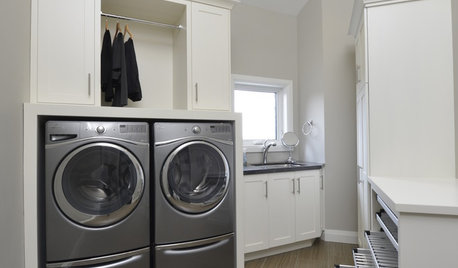Update on moldy Fisher and Paykel Washing MAchine
mrmichaeljmoore
14 years ago
Related Stories

HOUSEKEEPINGDishwasher vs. Hand-Washing Debate Finally Solved — Sort Of
Readers in 8 countries weigh in on whether an appliance saves time, water and sanity or if washing by hand is the only saving grace
Full Story
LAUNDRY ROOMSClever Ways to Hide a Laundry Station
When you don’t have a whole room to devote to the wash, use these solutions to tuck the machines out of view
Full Story
MOST POPULAR10 Smart Ideas for Your Laundry Room Remodel
Make washing and drying easier and more comfortable by considering ergonomics, storage and special features
Full Story
LAUNDRY ROOMSRoom of the Day: The Laundry Room No One Wants to Leave
The Hardworking Home: Ocean views, vaulted ceilings and extensive counter and storage space make this hub a joy to work in
Full Story
LAUNDRY ROOMS10 Great Laundry Room Ideas
Creative ways to sneak extra storage and time-savers into your laundry room
Full Story
INSIDE HOUZZUsing Houzz: Create a Home To-Do List
See how to use an ideabook to keep track of your home projects this year
Full Story
VACATION HOMESHouzz Tour: Snowy White Makeover for a Lake Tahoe Condo
Traditional alpine decor gets the boot in favor of a modern Scandinavian look in this Sierra Nevada getaway
Full Story
KITCHEN DESIGNA Cook’s 6 Tips for Buying Kitchen Appliances
An avid home chef answers tricky questions about choosing the right oven, stovetop, vent hood and more
Full Story
THE HARDWORKING HOMESmart Ways to Make the Most of a Compact Kitchen
Minimal square footage is no barrier to fulfilling your culinary dreams. These tips will help you squeeze the most out of your space
Full Story
BEDROOMS11 Reasons to Love White Bedding
For easy bedding that makes neutrals sing and accessories pop, look to the white side
Full StoryMore Discussions











dadoes
plumbly22
Related Professionals
Albany Kitchen & Bathroom Designers · 93927 Kitchen & Bathroom Remodelers · Lawndale Kitchen & Bathroom Remodelers · Berkeley Heights Cabinets & Cabinetry · Redwood City Custom Closet Designers · Kapolei Custom Closet Designers · Hercules Custom Closet Designers · Boca Raton Flooring Contractors · Cartersville Flooring Contractors · Costa Mesa Flooring Contractors · Jamaica Plain Flooring Contractors · Norton Flooring Contractors · Ocoee Flooring Contractors · South Lake Tahoe Flooring Contractors · Turlock Flooring Contractorsfordtech
czechchick2
dadoes
czechchick2
mrmichaeljmooreOriginal Author
sshrivastava
mrmichaeljmooreOriginal Author
dadoes
mrmichaeljmooreOriginal Author
gbsim1
pvc12
Nunyabiz1
dadoes
asolo
Nunyabiz1
dadoes
Nunyabiz1
mrjms
livebetter
asolo
Kappen
Nunyabiz1
livebetter
conate
mihi